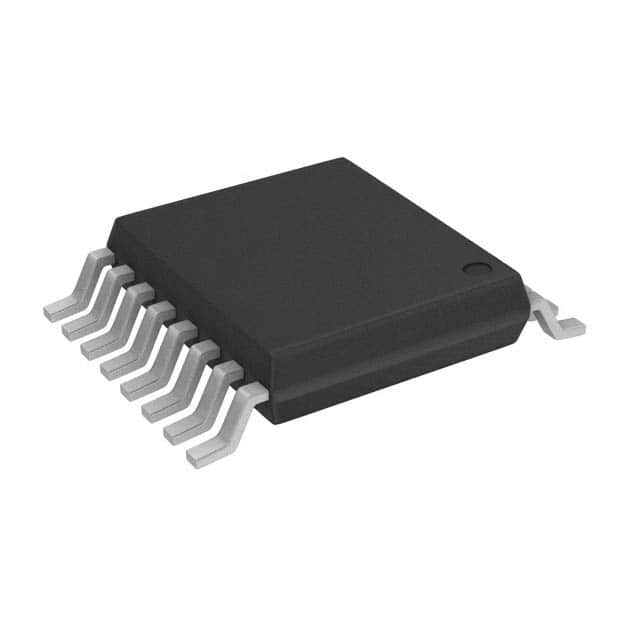Szczegóły produktu można znaleźć w specyfikacjach.

PI4IOE5V9538LE
Product Overview
- Category: Integrated Circuit
- Use: IO Expander
- Characteristics: High-speed, low-voltage, bidirectional voltage-level translation
- Package: QFN (Quad Flat No-leads)
- Essence: Expands the number of input/output pins of a microcontroller or other digital devices
- Packaging/Quantity: Available in reels of 2500 units
Specifications
- Operating Voltage: 1.65V to 5.5V
- Number of I/O Pins: 8
- I/O Voltage Level Translation: 1.2V to 5.5V
- Maximum Frequency: 400 MHz
- Interface: I2C (Inter-Integrated Circuit)
Detailed Pin Configuration
The PI4IOE5V9538LE has a total of 20 pins. The pin configuration is as follows:
- VCC - Power supply voltage
- GND - Ground
- SDA - Serial Data Line (I2C)
- SCL - Serial Clock Line (I2C)
- INT - Interrupt output
- OE - Output Enable
- A0 - Address bit 0
- A1 - Address bit 1
- I/O0 - Bidirectional I/O pin 0
- I/O1 - Bidirectional I/O pin 1
- I/O2 - Bidirectional I/O pin 2
- I/O3 - Bidirectional I/O pin 3
- I/O4 - Bidirectional I/O pin 4
- I/O5 - Bidirectional I/O pin 5
- I/O6 - Bidirectional I/O pin 6
- I/O7 - Bidirectional I/O pin 7
- VREF - Reference voltage for level translation
- SDA_EXT - External Serial Data Line (I2C)
- SCL_EXT - External Serial Clock Line (I2C)
- GND - Ground
Functional Features
- Bidirectional voltage-level translation between low-voltage and high-voltage domains
- Supports I2C interface for communication with the microcontroller or other devices
- Provides interrupt output for efficient event handling
- Output enable pin allows individual control of each I/O pin
- Address pins allow multiple devices to be connected on the same bus
Advantages and Disadvantages
Advantages: - High-speed operation up to 400 MHz - Wide operating voltage range - Small package size for space-constrained applications - Easy integration with microcontrollers and digital devices
Disadvantages: - Limited number of I/O pins (8 in total) - Requires external pull-up resistors for I2C communication
Working Principles
The PI4IOE5V9538LE is an IO expander that utilizes bidirectional voltage-level translation to expand the number of input/output pins of a microcontroller or other digital devices. It operates as an I2C slave device, communicating with the master device through the SDA and SCL lines.
The device translates the voltage levels between the low-voltage domain (1.2V to 5.5V) and the high-voltage domain (1.65V to 5.5V), allowing seamless communication between devices operating at different voltage levels. The bidirectional nature of the translation enables both input and output functionality for each I/O pin.
The PI4IOE5V9538LE also features an interrupt output pin, which can be used to signal events or trigger actions in the microcontroller. The output enable pin allows individual control of each I/O pin, enabling efficient power management and reducing overall power consumption.
Detailed Application Field Plans
The PI4IOE5V9538LE finds applications in various fields where there is a need for expanding the number of I/O pins. Some potential application areas include:
- Internet of Things (IoT) devices
- Industrial automation systems
- Consumer electronics
- Automotive electronics
- Robotics
- Medical devices
In IoT devices, the IO expander can be used to connect multiple sensors, actuators, and communication modules to a microcontroller with limited I/O pins. In industrial automation systems, it can facilitate the control and monitoring of various equipment and sensors. In consumer electronics, it can enable additional user interface elements or expand connectivity options.
Detailed and Complete Alternative Models
- PCA9538: Similar IO expander with 8 bidirectional I/O pins, I2C interface, and interrupt output.
- MCP23008: IO expander with 8 bidirectional I/O pins, I2C interface, interrupt output, and hardware address pins.
- **TCA6424
Wymień 10 typowych pytań i odpowiedzi związanych z zastosowaniem PI4IOE5V9538LE w rozwiązaniach technicznych
Sure! Here are 10 common questions and answers related to the application of PI4IOE5V9538LE in technical solutions:
Q: What is PI4IOE5V9538LE? A: PI4IOE5V9538LE is a low-voltage 16-bit I/O expander with an I2C interface, designed for use in various technical solutions.
Q: What is the purpose of using PI4IOE5V9538LE in a technical solution? A: The PI4IOE5V9538LE allows you to expand the number of available I/O pins on a microcontroller or other devices, providing additional flexibility in designing complex systems.
Q: How does PI4IOE5V9538LE communicate with the microcontroller or host device? A: PI4IOE5V9538LE communicates with the microcontroller or host device through the I2C bus, which is a widely used serial communication protocol.
Q: What voltage levels does PI4IOE5V9538LE support? A: PI4IOE5V9538LE supports both 3.3V and 5V voltage levels, making it compatible with a wide range of microcontrollers and devices.
Q: Can PI4IOE5V9538LE be used as both input and output pins? A: Yes, PI4IOE5V9538LE can be configured as either input or output pins, allowing for bidirectional communication with external devices.
Q: How many I/O pins does PI4IOE5V9538LE provide? A: PI4IOE5V9538LE provides 16 I/O pins, which can be individually controlled and configured.
Q: Can PI4IOE5V9538LE handle interrupts? A: Yes, PI4IOE5V9538LE supports interrupt functionality, allowing it to generate interrupts to the microcontroller or host device based on specific events.
Q: Is PI4IOE5V9538LE capable of driving external loads directly? A: PI4IOE5V9538LE has open-drain outputs and can drive external loads up to a certain current limit. However, for higher current requirements, additional drivers may be needed.
Q: Can multiple PI4IOE5V9538LE devices be used in a single system? A: Yes, multiple PI4IOE5V9538LE devices can be used in a single system by assigning unique I2C addresses to each device.
Q: Are there any application examples where PI4IOE5V9538LE is commonly used? A: PI4IOE5V9538LE is commonly used in applications such as industrial automation, home automation, robotics, IoT devices, and any other systems requiring additional I/O expansion.
I hope these questions and answers provide you with a good understanding of the application of PI4IOE5V9538LE in technical solutions!

